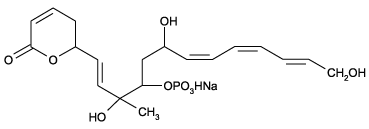Antitumor antibiotic. Catalytic inhibitor of topoisomerase II. Strong protein phosphatase 2A (PP2A) inhibitor (IC50=3.2nM). Weak inhibitor for PP1 (IC50=131µM). No apparent effect on PP2B. The binding site for fostriecin on PP2A is different from that of okadaic acid (see Prod. No. ALX-350-003).
Product Details
| Alternative Name: | Phosphotrienin, CI-920 |
| |
| Formula: | C19H26O9PNa |
| |
| MW: | 452.4 |
| |
| Source: | Synthetic. |
| |
| CAS: | 87860-39-7 |
| |
| RTECS: | UQ0600000 |
| |
| Purity: | ≥98% (HPLC) |
| |
| Appearance: | Colorless solid. |
| |
| Solubility: | Soluble in water (50mg/ml), methanol (10mg/ml) or 100% ethanol (10mg/ml). |
| |
| Shipping: | Ambient Temperature |
| |
| Long Term Storage: | -20°C |
| |
| Use/Stability: | Stable for at least 1 year when stored at -20°C. Use fresh solution. |
| |
| Handling: | Protect from light. Packaged under inert gas. Hygroscopic. |
| |
| Regulatory Status: | RUO - Research Use Only |
| |
Please mouse over
Product Literature References
Fostriecin: chemistry and biology: D.S. Lewy, et al.; Curr. Med. Chem.
9, 2005 (2002),
Abstract;
Phase I and pharmacokinetic study of the topoisomerase II catalytic inhibitor fostriecin: R.S. de Jong, et al.; Br. J. Cancer
79, 882 (1999),
Abstract;
Fostriecin, an inhibitor of protein phosphatase 2A, limits myocardial infarct size even when administered after onset of ischemia: C. Weinbrenner, et al.; Circulation
98, 899 (1998),
Abstract;
Fostriecin, an antitumor antibiotic with inhibitory activity against serine/threonine protein phosphatases types 1 (PP1) and 2A (PP2A), is highly selective for PP2A: A.H. Walsh, et al.; FEBS Lett.
416, 230 (1997),
Abstract;
Fostriecin: a review of the preclinical data: R.S. de Jong, et al.; Anticancer Drugs
8, 413 (1997),
Abstract;
Antitumor drug fostriecin inhibits the mitotic entry checkpoint and protein phosphatases 1 and 2A: M. Roberge, et al.; Cancer Res.
54, 6115 (1994),
Abstract;
Induction of DNA strand breaks associated with apoptosis during treatment of leukemias: W. Gorczyca, et al.; Leukemia
7, 659 (1993),
Abstract;
The cell cycle related differences in susceptibility of HL-60 cells to apoptosis induced by various antitumor agents: W. Gorczyca, et al.; Cancer Res.
53, 3186 (1993),
Abstract;
Comparison of effects of fostriecin, novobiocin, and camptothecin, inhibitors of DNA topoisomerases, on DNA replication and repair in human cells: C.M. Gedik & A.R. Collins; Nucl. Acids Res.
18, 1007 (1990),
Abstract;
Inhibition of type II topoisomerase by fostriecin: T.J. Boritzki, et al.; Biochem. Pharmacol.
37, 4063 (1988),
Abstract;
Anticancer activity of the structurally novel antibiotic Cl-920 and its analogues: W.R. Leopold, et al.; Cancer Res.
44, 1928 (1984),
Abstract;
Studies on the biochemical mechanism of the novel antitumor agent, CI- 920: D.W. Fry, et al.; Cancer Chemother. Pharmacol.
13, 171 (1984),
Abstract;
Novel antitumor agents CI-920, PD 113,270 and PD 113,271. I. Taxonomy, fermentation and biological properties: J.B. Tunac, et al.; J. Antibiot. (Tokyo)
36, 1595 (1983),
Abstract;
Novel antitumor agents CI-920, PD 113,270 and PD 113,271. II. Isolation and characterization: S.S. Stampwala, et al.; J. Antibiot. (Tokyo)
36, 1601 (1983),
Abstract;
Related Products












